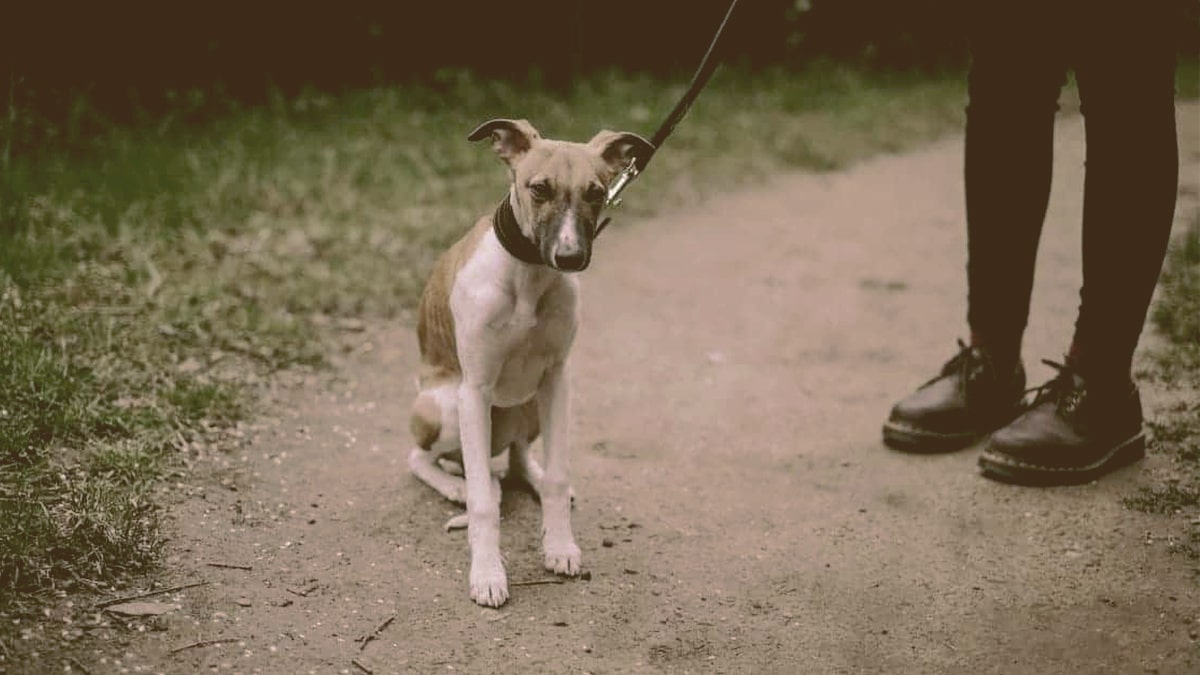
5 Reasons Your Dog Refuses To Walk And How To Fix It
Alex Vicente • Updated on August 1, 2023
- This review contains affiliate links. Read more here.
- Not a substitute for professional veterinary help.
Whether you’re a new owner or an experienced pet parent, you’ve likely experienced your dog suddenly stopping and refusing to walk.
This is certainly frustrating, but can also be dangerous if your dog stops on a busy street or around an unfriendly animal.
The first step to fixing this issue is figuring out why your dog is refusing to walk.
Each underlying reason has specific symptoms that you can measure your dog’s behavior against.
Table of Contents
Why Does My Dog Stop And Refuse To Walk?
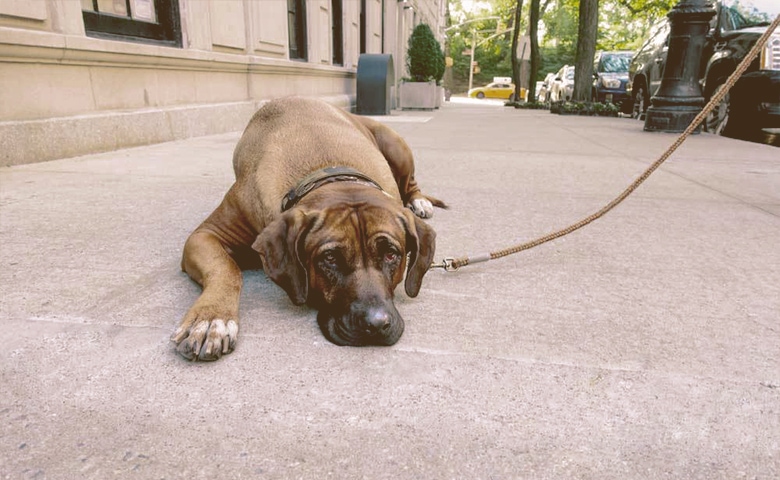
There are five primary reasons a dog stops and refuses to walk: medical issues or pain, overstimulation or exhaustion, fear or anxiety, a lack of training, and not wanting the walk to end. All dogs may be affected by these, although puppies, elderly dogs, and rescues are more prone to walk-related issues.
If your dog suddenly stops during a walk, you obviously want to find a way to get them going again. But to avoid making the core issue worse, you’ll need to figure out why your dog stopped in the first place.
Once you figure this out, you can begin addressing it. Sometimes it’s a quick fix, such as a rock stuck in their paw; other times it may be a more deep-seated problem, such as a fear of cars. Either way, you’ll be better equipped to help your dog and make sure walks are a happy experience.
Medical Issues/Pain

A common reason why dogs refuse to walk is pain or difficulty moving relating to medical issues. Dogs of all ages, genders, and breeds are affected by medical issues, some of which are common across these demographics and some of which may be specific to your dog.
There are some obvious signs of medical issues, such as if your dog is limping. But many dogs hide their pain, so it may not be obvious at first.
Here are a few medical issues that can all cause your dog to refuse to walk:
- Arthritis – Orthopedic issues that affect your dog’s joints, hips, or back may be causing discomfort when they walk for prolonged periods of time. As a result, they may stop and refuse to walk when the pain becomes overwhelming.
- Growing Pains – Similar to orthopedic issues, growing pains in puppies can cause discomfort on walks. This is especially true for large, fast-growing breeds, although it can happen to any puppy.
- Congenital Issues – Hip dysplasia and elbow dysplasia are two common congenital issues that can make it harder or painful for your dog to walk for extended periods of time. Large breeds are especially prone to such congenital issues.
Even if it’s not related to a medical issue, pain is still a strong motivation for a dog to stop walking. If their harness has rubbed them raw, the pavement is too hot or cold, or your pup has a sprained muscle, they’ll naturally want to cut the walk short.
Schedule an appointment with your regular veterinarian to see if an underlying medical issue is why your dog is refusing to walk. They’ll be able to perform a physical exam and run additional tests, if necessary.
You can also do a cursory exam of your dog at home. Check their paws for foreign objects and lightly run your hands over the rest of their body to see if one area, in particular, makes them tense up.
How To Fix The Problem
Depending on the medical issue your dog is suffering from, it may be necessary for you to cut walks out of your daily routine altogether. This may be temporary, but it may also be necessary for the rest of your dog’s lifespan.
Follow any instructions your veterinarian gives you and make follow-up appointments, if necessary. Make sure to give your dog medication if prescribed, such as pain killers.
Instead of going on walks, try different types of exercise to get your dog’s energy out. Examples of exercise that may be more appropriate include swimming, tracking scents, or learning new tricks. All of these will physically and mentally engage your dog.
Cutting down on the length and/ or frequency of the walks may also help if the vet has cleared your dog for walking.
If your dog stopped suddenly due to pain not related to a medical issue, get rid of the source of pain. Adjust the harness if it’s hurting them, remove the thorn from their paw, etc. Give them a day or two of rest, and painkillers if necessary, and then start them out on an abbreviated version of the walk to make sure they’re recovered.
Overstimulation Or Exhaustion
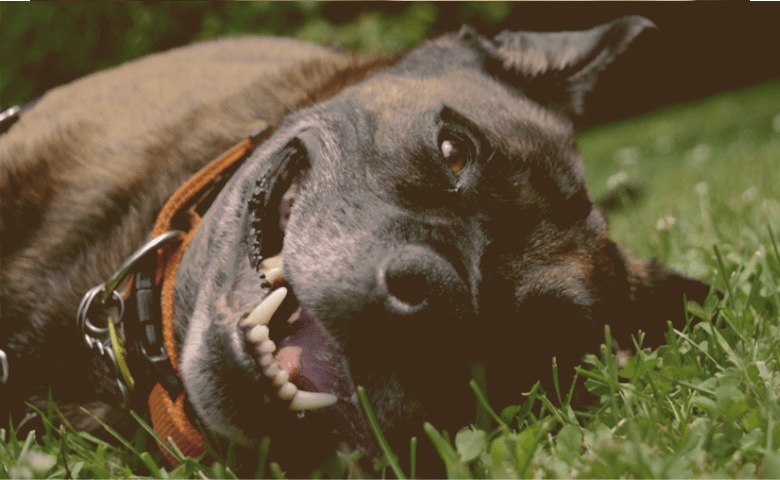
If your dog stops moving during a walk and refuses to budge, it may be overstimulated or exhausted. Either way, your dog needs a break and you need to isolate what’s causing these underlying issues so they don’t happen in the future.
These may seem like opposites— after all, overstimulated dogs are excited, while exhausted dogs are tired. But they share one core similarity: your dog is feeling one emotion really strongly, to the point that they can’t focus on anything else.
There’s nothing necessarily wrong with overstimulation or exhaustion. Dogs naturally become excited and tired. It only becomes a problem when these emotions are a reoccurring experience. Your dog shouldn’t become overstimulated to distraction or exhausted to the point of refusing to move every single day.
Puppies are especially prone to overstimulation and may become overwhelmed on walks. Similarly, rescued dogs may need a few weeks to settle in and feel comfortable enough to go on walks.
How To Fix The Problem
Both overstimulation and exhaustion can cause your dog to refuse to move in the middle of a walk. Below are some ways to address both of these:
- Overstimulation – Isolate your dog and patiently direct their attention to you or another object. The goal is to calm them down and refocus their energy. If necessary, use treats or recall commands.
- Exhaustion – Take a break and let your dog rest. You should always bring water on walks, so make sure to give them some. Check to see if they’re overheated. In the future, try reducing the length of the walk.
Typically, exhaustion is the more dangerous of the two. Depending on the weather, your dog may be in danger of overheating or mild hypothermia. Because of this, it’s important to check your dog’s physical state before going on a walk.
Fear Or Anxiety
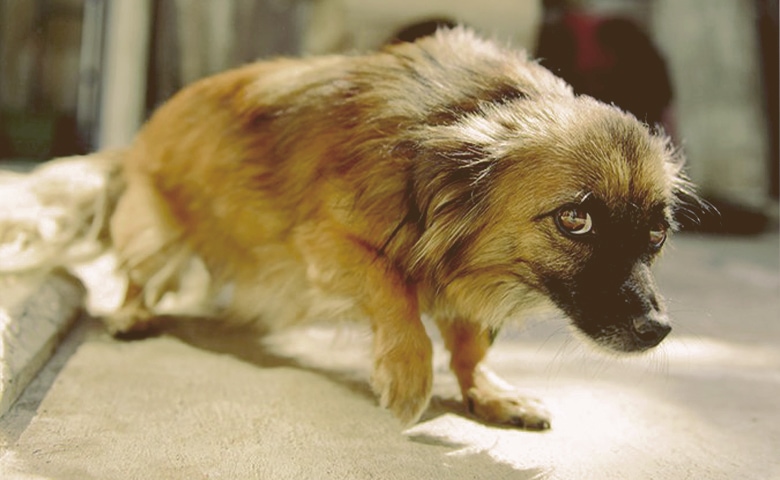
If new environments cause your dog to be fearful or anxious, they’ll be reluctant to go on walks and may have difficulty finishing a walk once started. Common stimuli that can trigger fear or anxiety are new or different smells, sounds, people, and places.
You may notice these triggers in your own home and backyard. For example, if your dog startles easily at loud noises or sudden movements, you can pinpoint these triggers.
Other times, it may be something on the walk itself that’s upsetting your dog. If this is the case, you’ll notice your dog is stopping at the same place, freezing after a certain period of time, or consistently reacting to another element of the walk.
It’s not uncommon for rescue dogs to have PTSD as a result of their previous bad experiences, especially dogs that came from abusive or neglectful households.
Remember, triggers aren’t always visible. Your dog may be reacting to something you can’t see, smell, or touch. When this happens, the best option is to observe. Do your best and try to figure out what’s upsetting them.
Besides refusing to move, common signs of fear or anxiety are heavy or irregular breathing and submissive posturing, which includes a tucked tail, crouched body, and flattened ears. Your dog may also try to hide or become aggressive toward what they perceive as the threat.
How To Fix The Problem
Here are some ways you can address your dog’s fear and anxiety:
- Changing Routes – If there’s an issue with the route you’re currently using for walks, try to change routes and avoid the trigger. This isn’t always realistic or practical, but a change of scenery may help.
- Counterconditioning – Your dog has formed negative associations with whatever is upsetting them (movement, certain scents, etc.). By breaking down those associations and replacing them with positive ones, you can help them overcome their fear.
- Desensitization – Rather than forming positive associations with a previous trigger, desensitization helps your dog become indifferent to it. The goal is that they eventually won’t react to it at all.
Besides refusing to move, common signs of fear or anxiety are heavy or irregular breathing and submissive posturing, which includes a tucked tail, crouched body, and flattened ears. Your dog may also try to hide or become aggressive toward what they perceive as the threat.
Training Issues
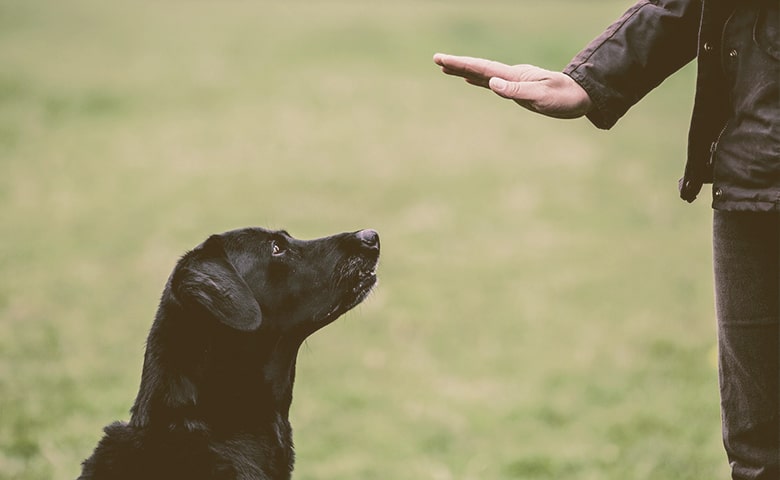
If your dog walks fine without a leash but freezes up or acts out when you put a leash or harness on them, then their refusal to walk is likely due to training issues. Leash training and manners are often essential since walking is one of the most common ways to exercise dogs.
Here are a few leash-training related reasons your dog may be reluctant to walk:
- Negative Associations – Depending on how you introduced the leash or harness, or your dog’s past experiences with walks, your dog may associate fear, anxiety, or other negative associations with walking.
- Unfamiliarity – Puppies obviously aren’t used to walking, but the same is true for some adult dogs as well. If your dog has no or minimal experience with leashes or harnesses, it may take time to become comfortable enough to walk around.
- Sizing Problems – If a collar or harness doesn’t fit right, it may be causing your dog discomfort. Make sure to read the sizing instructions before purchasing to make sure your dog is comfortable.
- Miscommunications – Understanding how to communicate with your dog is important. If a dog doesn’t understand your commands, walking may be more stressful than fun.
If your dog is prone to other behavioral issues, such as barking or chasing objects, then you may need to focus on resolving those issues before you tackle leash training.
Keep in mind, leash training is a gradual process that may take periodic reinforcement. Even once you leash train your dog, positive reinforcement can help to ensure their walking manners stay intact.
How To Fix The Problem
Leash training and related walking issues are a broad category, but there are some basic steps you can take to try and begin addressing them. Here are a few steps that you can begin implementing before, during, and after your walks:
- Make sure the sizing of the collar and harness is appropriate and that your dog can still move easily and without pain.
- Introduce the walking equipment into your dog’s at-home environment. For example, leave it next to their toys or near their food dish. This way, these are familiar and not foreign items to your dog.
- Bring along high-value treats so that you can reward your dog for walking well or overcoming sources of anxiety, stress, fear, etc. These treats will also serve as handy distractions or bribes if need be.
- Give your dog plenty of verbal praise and positive physical reinforcement. Especially do this when they display the desired trait, such as walking beside and not in front of you, but also do it periodically throughout the walk so it becomes a positive experience.
Depending on the severity of your dog’s negative associations, past trauma, or training issues, you may need to consult with a professional trainer. They’ll be able to direct you on how to best help your dog going forward without making their issues worse.
Not Wanting The Walk To End
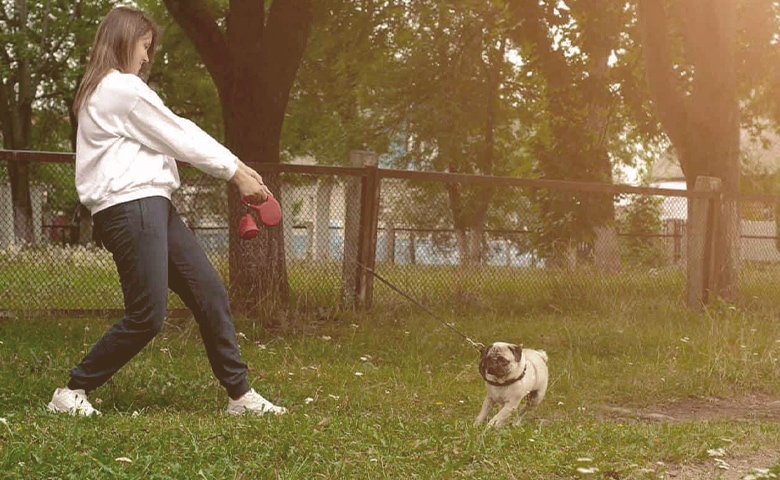
If your dog suddenly stops and refuses to continue walking, the reason may be as simple as them not wanting the walk to end. Dogs that especially enjoy walking and those with high energy levels are especially known for this.
Here are a few reasons your dog might not want to end their walk:
- Understimulation – If your dog isn’t getting enough stimulation or enrichment at home, they may be relying on the walk to receive their fill for the day. As a result, they won’t want to leave until they’re done sniffing and exploring every single item.
- Lack of Exercise – Dogs with a high drive need lots of exercise, but even dogs that are lazy need to work out pent-up energy. If they’re not getting enough exercise at home, they’ll be reluctant to stop walking and return to being cooped up.
- Having Fun – When a dog is having fun, it’s natural for them to want to keep having fun. If your pup just really (really) loves walks, start introducing another activity they love at the end of walks. This way, they look forward to returning home.
- Seeking Attention – At home, your attention is likely to split. But on walks, most of your attention is on your dog. And when they stop and refuse to walk, they definitely have your undivided attention.
The process of elimination is usually the easiest way to figure out if this is the case for your dog. Run down the list of other reasons why your dog might have stopped and try to cross off the pain, fear/ anxiety, overstimulation, exhaustion, and bad manners as possibilities.
Once you’re reasonably sure your dog is just stopping because they don’t want the walk to end, try testing this theory. If your dog is stopping, then they likely recognize the route and realize you’re heading home.
Try turning in the opposite direction and seeing if your dog is eager to walk again. Alternatively, you could change the route entirely on your next walk and see if they refuse to move at any point.
How To Fix The Problem
Comparatively, this is one of the easiest issues to address with your dog. At its core, this issue is about your dog’s environment and whether or not all of their needs are being met.
If it’s a physical problem (i.e., under stimulation or lack of exercise), then you can incorporate more exercise into their routine.
This is also a great solution for dogs that enjoy going on walks more than they enjoy returning home. After you finish each walk, try to immediately reward your pup or engage them in an activity they find equally enjoyable.
Here are some activities that will burn off your dog’s excess energy and get them excited at the same time:
- Invest in new toys, puzzle games, and moving toys.
- Try to lengthen the walks or take long walks.
- Consider energy-burning activities like playing fetch or chasing a frisbee.
- Set up the sprinklers or another water-based activity.
- Use foraging toys or scenting games to give them treats.
And when it comes to giving them more attention, the activities above can help with that, too. They involve more dedicated one-on-one time between you and your dog, which should (hopefully) satisfy your pup’s emotional needs.
What Do You Do When Your Dog Doesn’t Want To Walk?
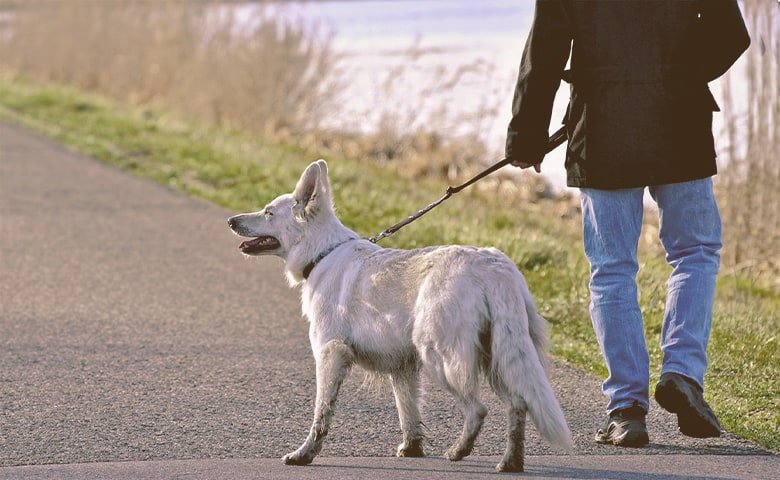
If your dog doesn’t want to walk, the most important thing to remember is not to use physical force. Instead, focus on short-term solutions for getting your dog to walk again, such as offering treats or just waiting. Preferably, you should use a method that addresses the underlying reasons why they’re not walking.
We’ve already discussed some ways to solve each of the five most common reasons dogs suddenly stop walking and refuse to move. Some of these are quick fixes, while others are a start to addressing the deeper-seated issues.
Remember, don’t feel like you have to work alone. Professionals like veterinarians and trainers are there to help you give your pup the best life possible. They’ll be able to identify specific issues related to walking and provide you with tools to solve them.
Should You Drag A Dog That Won’t Walk?
Trying to drag a dog that’s reluctant to walk will only make them more reluctant. They’ll lean away from or fight against any pressure that you put on the leash, making the problem worse.
Besides being counterproductive, dragging your dog along the street or sidewalk can also be dangerous. You may accidentally harm them, which adds medical issues on top of walking issues. This can cause them to be even more reluctant to walk.
Instead of using more force, you should try to identify and address the underlying issues that are causing your dog to refuse to walk. This is much more effective than using brute strength to muscle through the rest of the walk.
If you haven’t managed to pinpoint the underlying issue that’s making your dog stop during walks, here are some temporary solutions that may tempt your dog to start moving again:
- Rewards – Bringing treats on a walk is an easy backup method of getting your dog to move again. Give them a taste of the treat and then tempt them forward with more. Alternatively, try praising them and getting them excited to start walking again.
- Breaks – It could be that your dog just needs a break. If possible, sit down with your dog and take a few minutes to pay them attention. Check their paw pads, pet them, offer water, and see if they’re ready to start walking again after a short break.
- Stimuli – If your dog is refusing to walk because they’re hyper-focusing on something (for better or worse), try distracting them with different stimuli. This could be in the form of treats or a toy you brought along, or you can direct their attention to the environment.
When you get home, double-check to make sure there’s not an obvious they stopped walking. Watch to see if they drink a lot of water, immediately seek out a cool place, or are not putting pressure on a certain leg.
Can You Over Walk A Dog?
Overwalking your dog is a very real and potentially very dangerous habit. While walking is a great way to make sure your dog gets exercise, overwalking them can cause more harm than good. And if you make it a habit, it can cause your dog to avoid walks altogether.
The amount of exercise your dog needs will depend on its breed, age, size, and health. In turn, all of these will contribute to their energy levels.
What’s appropriate for one dog can be dangerous for another. For example, large breeds may enjoy walking for a few miles every day. But forcing a small breed to walk a mile or more at one time can cause them to overheat or damage their paws.
How Many Times Should A Dog Be Walked?
The number of times you should walk your dog (per day and per week) depends on their age, health, and energy levels. A good rule of thumb is at least once per day for a minimum of 30 minutes.
Puppies under the age of six months should either not be walked at all or only allowed very short walks. This is because their bones and joints are still forming, so extended walks can actually stunt their growth.
Similarly, dogs with serious health issues shouldn’t go on extended walks. This is especially true if their medical problems are related to their joints, back, or hips.
Adolescent and adult dogs can be walked a mile or more, multiple times per day. Keep in mind, this will depend on your dog’s energy level. Some dogs are more sedate and are satisfied with one walk per day. Others seem to have unlimited energy and would love to walk three times per day.
If you’re unsure about how much walking your dog can handle, start with one walk per day that’s a mile or less. Gauge their physical and mental state after and keep these questions in mind:
- Are they tired or energetic? If they’re tired, are they just worn out or do they seem unduly exhausted?
- Are they tired but still restless? If so, it may be that the walk needs to be more engaging versus longer.
- Do they seem excited about another walk or are they indifferent when you pull out the leash?
The answers to these questions will serve as a benchmark for whether you need to length or shorten the walk. It will also tell you if the route is engaging enough for your dog to be satisfied.
Final Thoughts
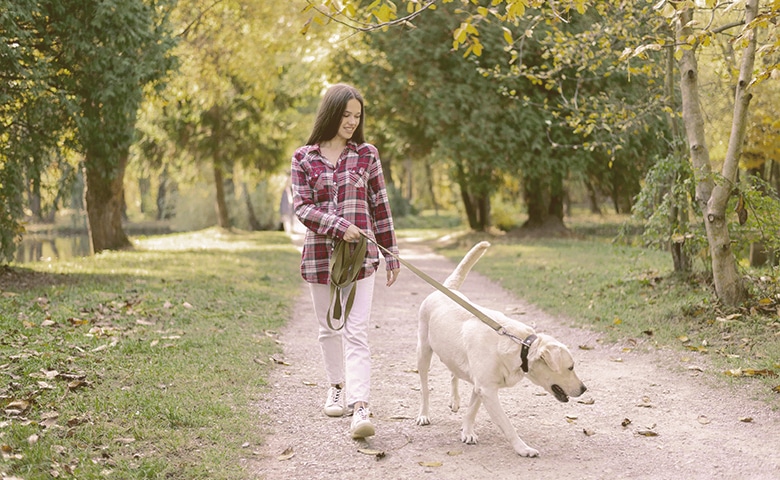
When your dog suddenly stops moving on a walk and refuses to move, the reason usually falls into one of five categories: medical issues or pain, overstimulation or exhaustion, fear or anxiety, training issues, and not wanting the walk to end.
Each of these is indicative of underlying issues that need to be addressed to have peaceful, fun walks in the future. Thankfully, there are short- and long-term solutions for every issue that dog owners can begin implementing.


